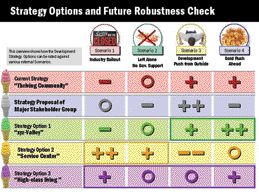
News
Community Refocus: Challenges with the exit of a major employer
April 1, 2006 By Pulp & Paper Canada

Finding a new long-term focus for the community is the main challenge after exit of a major employer or the closure of a manufacturing facility and it is essential that all stakeholders be heard and r…
Finding a new long-term focus for the community is the main challenge after exit of a major employer or the closure of a manufacturing facility and it is essential that all stakeholders be heard and represented in the change process. In many cases, hidden potentials for the region that could form the basis for a new economic base already exist. However, without a structured approach, diverse stakeholder interests can derail the change process and present difficulty in uncovering these opportunities and reaching consensus on a shared vision and path forward project prioritization.
Experience and best practices with Community Refocus projects has highlighted a number of common themes around uncertainty and organizational dilemmas.
No common understanding for the implications of the future: Communities are often faced with a black-and-white perspective of the future — at least at the stakeholder level. Different stakeholder perspectives frequently deadlock tactical decision-making and create poor strategic focus.
Uncontrollable change process, such as the exit of a major employment base: When unexpected “shock-change” occurs, it often becomes apparent that long-range planning has been neglected and alternate foundations for the community are needed — sometimes urgently.
Unrealized governance and potential for change: Communities often fail to recognize their true potential for changing the course of their future. They fall into two groups:
Overconfidence in own abilities leads to an underestimation of uncontrollable external forces, [e.g. global markets, migration patterns, demographic shifts, regulations, environmental challenges, etc.]. Overconfident communities often waste resources battling the inevitable and have no alternatives if their ambitious Plan A fails.
A community low in confidence might underestimate its ability to influence change by failing to exploit the lobbying power of its elected representatives and significant leaders. Low confidence often results in a disorganized approach to community planning, without a clear agenda or vision. Such a community will fall victim to external forces.
Diverse stakeholder interests: Without a systematic review of diverse stakeholder interests, commitment to path forward solutions will be impeded. Unrecognized stakeholder interests frequently emerge to jeopardize previously laid plans. Experience has shown that there is more hidden consensus in a community than might be exhibited by the political or representative leaders. Processes are required to listen for and clarify hidden consensus.
Resistance to change: Communities perceive sudden change as a threat to tradition, continuity and way of life. Resistance to this change is difficult to overcome by simply imposing change, even through elected representatives.
Need for a structured approach to future-oriented strategic planning: Many communities try to achieve a plan that is created through established channels and institutions. This often solidifies the stakeholder conflicts by assigning authority. A structured, holistic approach by an unbiased third party can facilitate the strategic planning process more effectively.
Why is this important?
It is important to generate alternate self-consistent strategic plans that provide choices for the most advantageous path forward. The best strategy (or ice cream flavour) may then be selected in accordance with different regional scenarios, (in the example figure, Strategy Option 1, 2, or 3 may be preferred under different external Scenario conditions). A steering scenario for a desired future can also be incorporated into this approach. Research, education, tourism and retirement are examples of alternate economic drivers for a region that may provide a compliment or alternative to a future commercial focus. An outside facilitator with no internal baggage is in a better position to steer the change process. The public at large can also be involved through newspaper coverage and public opinion questionnaires. Coalition building, for the public benefit, amongst opposing stakeholders is another key requirement. The ability to manifest the community as resourceful and organized, with a sense of urgency, optimism and “can-do” planning are additional intangible benefits.
The author can provide further details concerning several successful community refocus projects in Europe.
Alan Procter is an international consultant and strategic advisor. He can be reached through www.alanprocter.com
Print this page